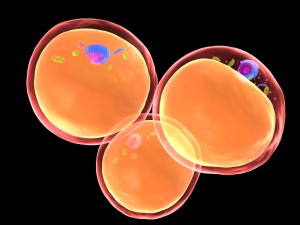
Fat loss involves complex metabolic processes that begin at the cellular level.
Ah, the visual joy of weight loss—your face is more defined, your belly no longer protrudes over the waist of your pants, and parts that used to jiggle are now toned. On the outside, fat loss seems like a fairly simple process. However, what happens in your body during weight loss involves an intricate web of metabolic changes that include structural transformation of fat cells, the breakdown and use of fat for energy, as well as changes in hormone production.
Performing Isagenix Cleanse Days—a combination of intermittent fasting with herbs and vitamins that support detoxification—is an effective approach for weight loss, especially for targeting fat loss. In fact, the
UIC study using Isagenix products found that those who follow the Isagenix system had more fat loss and twice as much visceral fat loss than those who followed a “heart healthy” diet.
How does fat loss occur when you incorporate Cleanse Days into your routine? To understand, we’ll have to start with the basics, or Fat 101:
Getting to know fat
Adipose tissue—or body fat—is comprised of millions of fat cells, also called adipocytes, with the average adult having around 40 billion. The weight of adipose tissue is about 20 percent of body weight, making it one of the biggest organs in the body.
Fat can be defined by where it’s found in the body: subcutaneous fat is located just below the surface of the skin while visceral fat is found in the abdominal cavity, surrounding the internal organs. Furthermore, there are two types of adipose tissue: white and brown. White adipose tissue is primarily used as an energy reserve and brown adipose tissue functions to generate heat.
Adipose tissue is a metabolically active organ rather than just an inert mass as many may have guessed. In fact, each depot of the organ even receives its own vascular and nerve supply.
Adipose tissue has been identified as an endocrine organ because of its production of hormones known as adipokines. These signaling proteins influence several important functions including glucose and lipid metabolism, blood coagulation, insulin sensitivity, blood pressure, and steroid hormone modulation (1). Excessive adipose tissue has been shown to disrupt the normal endocrine functions of fat cells and can negatively affect health through insulin resistance, abnormal blood lipids, and even increased cardiovascular disease risk.
Leptin is an adipokine that regulates hunger and appetite by telling the brain, “I’m full!” Although intuition may assume that leptin levels would be low in obese individuals due to chronically excessive food intake, the opposite is true. Leptin has been shown to be tightly related to fat cell size: the bigger the adipocyte, the greater the expression of leptin (2).
This would mean that obese persons are constantly feeling full, right? Wrong. Obesity is associated with resistance to the effects of leptin on the brain appetite centers, so they actually end up having an impaired response that doesn’t indicate fullness. This exemplifies how complex the relationship is between adipose tissue and the endocrine system.
Fat cells increase in size, then in number
When energy balance becomes positive (meaning there are more calories consumed than burned), the adipose organ increases, particularly in the amount of white adipose tissue. White adipocytes undergo hypertrophy (increase in volume) followed by hyperplasia (increase in number).
It’s been proposed that adipocytes have a maximum volume, referred to as “critical cell size” that may be genetically determined (3). This means that fat cells can only get so big. Once they reach their critical cell size, they trigger production of new adipocytes. In other words, your existing fat cells are filled until they reach their capacity (much like a balloon) and then signal the body to make more fat cells.
You are more likely to make additional fat cells at certain times in your life. Research has shown that the natural production of fat cells steadily increases during childhood and levels off in early adulthood (4). Although more research is needed, this could indicate that children who are obese are more likely to be obese as adults and experience greater difficulties in trying to achieve weight loss.
How the body burns fat
When energy balance is negative in the body (meaning there are more calories being burned than consumed), the hormones that access stored fuel are increased, namely glucagon. In short, the body flips from an energy-storing state to an energy-burning state.
First, the body will burn stored carbohydrate, also known as glycogen, which is found mostly in the liver and muscles. Once the glycogen energy reserve has been exhausted, the body breaks down fat in a process called lipolysis.
What happens to fat cells during weight loss?
During negative energy balance such as on Cleanse Days, the body will use the fat for fuel causing the fat cells to shrink in size. As fat cells decrease in size, so too does the amount of signaling molecules produced. Over time, this reestablishment of normal endocrine function can be immensely beneficial for health including decreasing the molecules that induce inflammation.
Additionally, fat loss accompanied by adequate intake of optimal nutrition—such as vitamins (B vitamins, vitamins C and E), minerals (selenium, zinc, copper), and other bioactive nutrients including coenzyme Q10 and polyphenols—support the detoxification systems of the body in the removal of toxins. (Read more in
The Basics of Detoxification.)
It is interesting to note that fat cells have the ability to shrink but rarely decrease in number. However, during fat loss, cells can decrease as much as 400 percent in size! For many, this morphological transformation supported by dietary interventions such as Cleanse Days means more than just a slimmer appearance; it can improve health and even add years of quality life.
Interested in losing fat? www.fatbgone.org
References
1. Rossmeislova L, Malisova L, Kracmerova J, Stich V. Adaptation of human adipose tissue to hypocaloric diet.
Int J Obes (Lond) 2013;37:640-50. doi:
10.1038/ijo.2012.80
2. Skurk T, Alberti-Huber C, Herder C, Hauner H. Relationship between adipocyte size and adipokine expression and secretion.
J Clin Endocrinol Metab 2007;92:1023-33.
3. Cinti S. The adipose organ at a glance.
Dis Model Mech 2012;5:588-94.
4. Spalding KL, Arner E, Westermark PO et al. Dynamics of fat cell turnover in humans.
Nature2008;453:783-7. doi:
10.1038/nature06902
 I recently saw a research finding from 2009 that was pretty interesting. Canadian scientists studied people who self-identified as “morning people” or “night people” and found striking differences in brain activity patterns between the two groups. They noticed that neuronal excitability started high and decreased throughout the day for morning people, and started low and increased for night people.
I recently saw a research finding from 2009 that was pretty interesting. Canadian scientists studied people who self-identified as “morning people” or “night people” and found striking differences in brain activity patterns between the two groups. They noticed that neuronal excitability started high and decreased throughout the day for morning people, and started low and increased for night people.


 I recently saw a research finding from 2009 that was pretty interesting. Canadian scientists studied people who self-identified as “morning people” or “night people” and found striking differences in brain activity patterns between the two groups. They noticed that neuronal excitability started high and decreased throughout the day for morning people, and started low and increased for night people.
I recently saw a research finding from 2009 that was pretty interesting. Canadian scientists studied people who self-identified as “morning people” or “night people” and found striking differences in brain activity patterns between the two groups. They noticed that neuronal excitability started high and decreased throughout the day for morning people, and started low and increased for night people.














